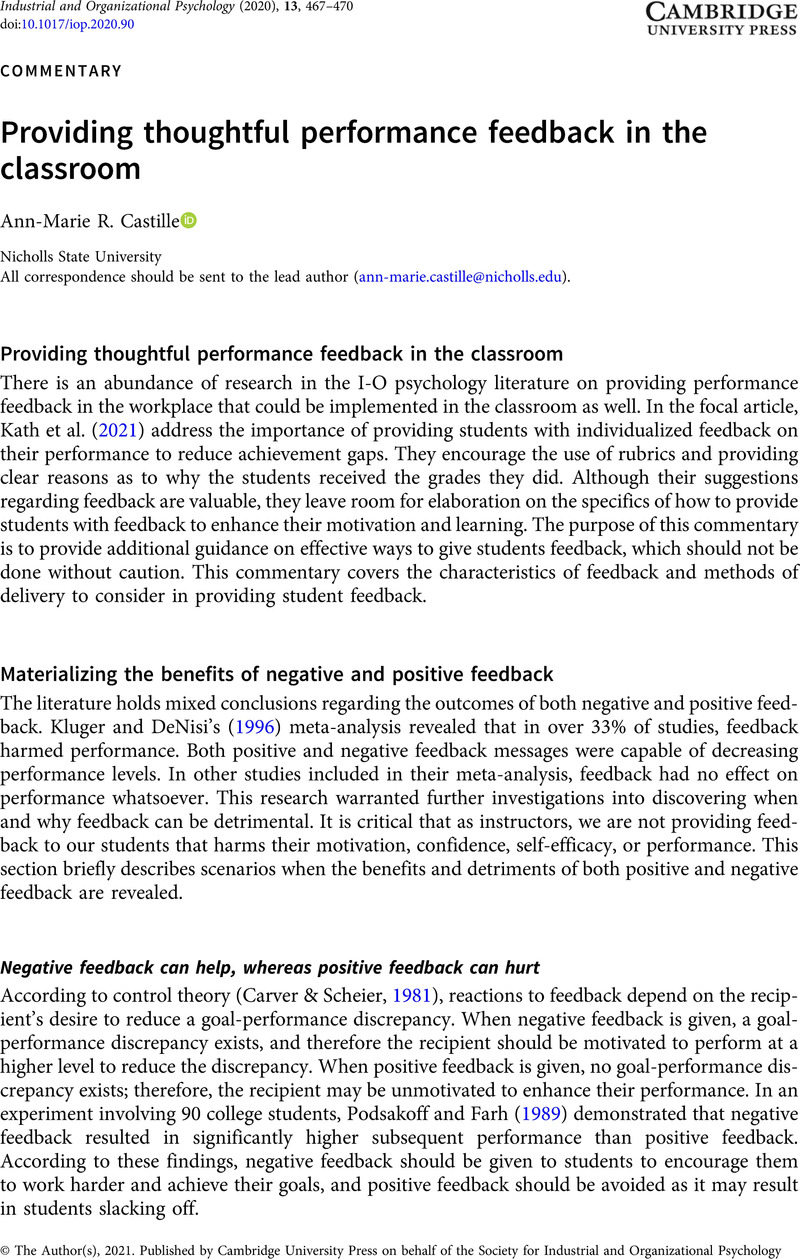No CrossRef data available.
Article contents
Providing thoughtful performance feedback in the classroom
Published online by Cambridge University Press: 08 February 2021
Abstract
An abstract is not available for this content so a preview has been provided. Please use the Get access link above for information on how to access this content.

- Type
- Commentaries
- Information
- Copyright
- © The Author(s), 2021. Published by Cambridge University Press on behalf of the Society for Industrial and Organizational Psychology
References
Bandura, A. (1986). Social foundations of thought and action: A social cognitive theory. Prentice Hall.Google Scholar
Bouffard-Bouchard, T. (1990). Influence of self-efficacy on performance in a cognitive task. Journal of Social Psychology, 130(3), 353–363.CrossRefGoogle Scholar
Carver, C. S., & Scheier, M. F. (1981). Attention and self-regulation: A control-theory approach to human behavior. Cambridge University Press.CrossRefGoogle Scholar
Henley, A. J., & Reed, F. D. (2015). Should you order the feedback sandwich? Efficacy of feedback sequence and timing. Journal of Organizational Behavior Management, 35(1), 321–335.CrossRefGoogle Scholar
Ilies, R., & Judge, T. A. (2005). Goal regulation across time: The effects of feedback and affect. Journal of Applied Psychology, 90(3), 453–467.CrossRefGoogle ScholarPubMed
Jacobs, M., Jacobs, A., Feldman, G., & Cavior, N. (1973). Feedback II-The “credibility gap”: Delivery of positive and negative and emotional and behavioral feedback in groups. Journal of Consulting and Clinical Psychology, 41(2), 215–223.CrossRefGoogle ScholarPubMed
Jeffrey, S. A., Schulz, A., & Webb, A. (2012). The performance effects of an ability-based approach to goal assignment. Journal of Organizational Behavior Management, 32(3), 221–241, DOI: 10.1080/01608061.2012.698116
CrossRefGoogle Scholar
Kath, L., Salter, N., Bachiochi, P., Brown, K., & Hebl, M. (2021). Teaching I-O psychology to undergraduate students: Do we practice what we preach? Industrial Organizational Psychology: Perspectives on Science and Practice, 13(4), 443–460.Google Scholar
Kluger, A. N., & DeNisi, A. (1996). The effects of feedback interventions on performance: A historical review, a meta-analysis, and a preliminary feedback intervention theory. Psychological Bulletin, 119(2), 254–284.CrossRefGoogle Scholar
Locke, E. A., & Latham, G. P. (1990). A theory of goal setting & task performance. Prentice-Hall, Inc.Google Scholar
Moon, S. H., Scullen, S. E., & Latham, G. P. (2015). Precarious curve ahead: The effects of forced distribution rating systems on job performance. Human Resource Management Review, 26(2), 166–179.CrossRefGoogle Scholar
Podsakoff, P. M., & Farh, J. (1989). Effects on feedback sign and credibility on goal setting and task performance. Organizational Behavior and Human Decision Processes, 44(1), 45–67.CrossRefGoogle Scholar
Stockton, R. A., & Morran, D. K. (1981). Feedback exchange in personal growth groups: Receiver acceptance as a function of valence, session, and order of delivery. Journal of Counseling Psychology, 28(6), 490–497.CrossRefGoogle Scholar
Wang, S. L., & Wu, P. Y. (2008). The role of feedback and self-efficacy on web-based learning: The social cognitive perspective. Computers & Education, 51(4), 1589–1598.CrossRefGoogle Scholar


